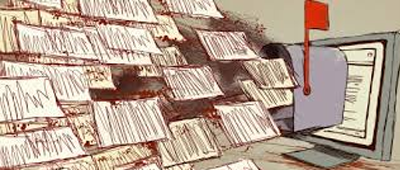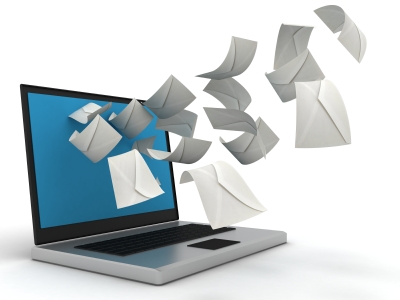
New Year, New Inbox: Tips for Better Email Management
Email is a fundamental aspect of our jobs in today’s technologically driven age. So much so that we spend 28% of our workweek focused on reading and answering emails, which doesn’t sound like much until you realize that equals roughly 11 hours of a 40-hour workweek—and that doesn’t account for jobs that focus solely on email interaction like customer service!
Yet despite how important emails are to most occupations, the majority of individuals dread looking at their inbox, let alone addressing all the unopened messages. But there is a method to taming the madness; there is a way to manage your email to make it work for you instead of against your free time. Following these tips guarantees a lighter inbox and peaceful state of mind.
Folders/Labels Are Your Friend
Folders (or labels if you use Gmail) are an excellent starting point for organizing your inbox. Classifying the types of emails you receive and sorting your current messages under specific topics will begin emptying your inbox and help with future searches for specific emails.
If you’re the type of person who has over 3,000 emails in your inbox right now, going through each one and classifying what folder they belong to isn’t a good idea. Best bet is to make one folder titled “2013 to the Beginning” and file all your emails from that time frame in there right now. That act alone should be a big sigh of relief.
Now that your inbox has (hopefully) less than 100 emails, you can begin to tackle sorting messages into their designated category: personal emails, client A, project X, receipts, etc. This will take some time, so schedule at least a one-hour block one day to complete this task. Here’s a how to create labels for Gmail, folders for Yahoo mail and for Hotmail. Archiving is an alternative to all this, but using folders makes it a better searchable strategy.
Keep the Emails that Require your Attention Front and Center
By sifting emails into folders, your inbox should now ONLY have the important emails that require a response. Once you reply to the emails you can respond to, move that email into a folder—this way, you know you’ve taken care of your side of the correspondence and now all you can do is wait on the recipient’s reply.
If an email is very urgent and time sensitive of the recipient’s response, then it might be best to leave the email in your inbox so you don’t forget about it, but that also doesn’t mean your inbox should return to its old state.
Better yet, you can even create a folder titled “FOLLOW-UP” that you train yourself to look at before the end of every workday. Another option is keeping emails that call for a response marked as unread, making it a good visual reminder to attend to that email when you can.
Create Filters
Filtering is a fantastic tool for forwarding emails you know you’ll never read but continue to receive, such as company newsletters or press releases. If you’d rather not unsubscribe (or simply can’t) then filtering is the way to go.
Gmail, for example, gives you the option to pinpoint email addresses, subject headings, and specific words to create a filter from, to then either forward to a specific folder, mark as read, or automatically delete.
Use the Vacation Responder for More than Just Vacation
The vacation responder is the lovely tool that notifies everyone who emails you that you’re out of the office, enjoying a martini on a beach somewhere during the holidays. But it can be more than that. Using the vacation responder on those days your inbox is just overflowing, a tip I picked up from writing consultant Alexandra Franzen, is a way to let your clients and fellow employees know that you’re just really busy, not ignoring their email. It’s a personal, even if automated, touch to making the entire email process simpler.
And if you’re the type of person who receives the same questions over and over again, you can write up a small FAQ (or link to one) that goes in your vacation responder to automatically answer a majority of your emails without lifting a finger.
Punctation Is Your Friend: + and .
Did you know you can append a plus (“+”) sign and any words after in your email address? Whatever for, you may ask? It’s a great tool for grouping mailing list emails together, for instance, or knowing the origins of why you may be receiving an email from a company you’ve never heard of.
Let me explain:
- If your name was ilovegrapes@gmail.com, you could receive mail at ilovemovies+newsletters@gmail.com, and use that address when signing up for company lists. Then, you can setup a filter to have those emails automatically go to a folder to not clog your inbox!
- Have you ever received a newsletter only to wonder how they even got your email in the first place? Well it can be easy using this tip. If you use ilovemovies+starbucks@gmail.com to sign up for Starbucks emails, and the message from a third-party stranger is using that address, then that means Starbucks provided them with your email. Someone has some explaining to do!
- What about the dot (“.”)? For Gmail in particular, that dot doesn’t matter! If your email is ilovemovies originally, you can tell people it’s i.love.movies or ilove.movies or i.lovemovies@gmail! Possibilities are endless.
Ignoring Emails Is Not a Solution
It’s quite discouraging when you take the time to send a very important and detailed email, only to never hear a peep from the recipient. The usual complaint is, “Well we’re busy! Our inboxes are flooded so we don’t have the time to respond to every inquiry.” But that can change; you can be THAT person who responds to every inquest who in turn will acquire a reputation for being quick and responsive—believe me, it’s such a rarity that others DO take notice and appreciate you for it.
In general, ignoring emails just creates more clutter because people usually follow-up on their inquiry, frustrating both parties. Avoid making those emails haunting reminders of the state your inbox was formerly in. Once you begin to organize your emails with these tips, you’ll find yourself with more time on your hands to answer people’s individual requests. Overall, the time saved will not only allow you to respond to emails at lightning speed, you’ll be able to focus on other projects and change the way you see your inbox forever.







